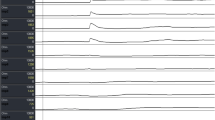Abstract
Heart rate variability (HRV) biofeedback is an emerging treatment for many health conditions involving dysregulation of the autonomic nervous system including hypertension, gastric pain, anxiety, and depression. Hiccups are frequently considered an annoyance. However, when intractable (lasting over 1 month), they can become debilitating, with some patients resorting to invasive treatments that often involve the phrenic nerve. Theoretically, HRV biofeedback should also provide a means to stimulate the phrenic nerve and could be an alternative option. We report the successful treatment of a 5 year-long case of intractable hiccups with one session of HRV biofeedback training. These results suggest that biofeedback may be a useful, non-invasive means of relieving intractable hiccups. No clear causality can be inferred from a single case, and further study is needed to determine if this finding has wider applicability.
Similar content being viewed by others
References
Hallman, D. M., Olsson, E. M. G., von Schéele, B., Melin, L., & Lyskov, E. (2011). Effects of heart rate variability biofeedback in subjects with stress-related chronic neck pain: A pilot study. Applied Psychophysiology and Biofeedback, 36, 71–80.
Hamdan, M. H., Joglar, J. A., Page, R. L., Zagrodzky, J. D., Sheehan, C. J., Wasmund, S. L., et al. (1999). Baroreflex gain predicts blood pressure recovery during simulated ventricular tachycardia in humans. Circulation, 100(4), 381–386.
Hassett, A. L., Radvanski, D. C., Vaschillo, E. G., Vaschillo, B., Sigal, L. H., Karavidas, M. K., et al. (2007). A pilot study of the efficacy of heart rate variability (HRV) biofeedback in patients with Fibromyalgia. Applied Psychophysiology and Biofeedback, 32, 1–10.
Kolodzik, P. W., & Eilers, M. A. (1991). Hiccups (Singultus): Review and approach to management. Annals of Emergency Medicine, 20(5), 565–573.
La Rovere, M. T., Bigger, J. T., Marcus, F. I., Mortara, A., & Schwartz, P. J. (1998). Baroreflex sensitivity and heart-rate variability in prediction of total cardiac mortality after myocardial infarction. The Lancet, 351(9101), 478–484.
Lee, M. H., Pritchard, J. M., & Weiner, W. J. (2011). Clinical reasoning: A 44-year-old-man with a 3-month history of hiccups. Neurology, 77(24), e145–e148.
Lehrer, P., & Vaschillo, E. (2008). The future of heart rate variability biofeedback. Biofeedback, 36(1), 11–14.
Lehrer, P. M., Vaschillo, E., Vaschillo, B., Lu, S.-E., Eckberg, D. L., Edelberg, R., et al. (2003). Heart rate variability biofeedback increases baroreflex gain and peak expiratory flow. Psychosomatic Medicine, 65, 796–805.
Lehrer, P. M., Vaschillo, E., Vaschillo, B., Lu, S.-E., Scardella, A., Siddique, M., et al. (2004). Biofeedback treatment for asthma. Chest, 126(2), 352–361.
Loft, L. M., & Ward, R. F. (1992). Hiccups: A case presentation and etiologic review. Archives of Otolaryngology—Head and Neck Surgery, 118, 1115–1119.
Marinella, M. A. (2009). Diagnosis and management of hiccups in the patient with advanced cancer. Journal of Supportive Oncology, 7(122–127), 130.
McCraty, R., Atkinson, M., & Tomasino, D. (2003). Impact of workplace stress reduction program on blood pressure and emotional health in hypertensive employees. The Journal of Alternative and Complementary Medicine, 9(3), 355–369.
Payne, B. R., Tiel, R. L., Payne, M. S., & Fisch, B. (2005). Vagus nerve stimulation for chronic intractable hiccups: Case report. Journal of Neurosurgery, 102(5), 935–937.
Rousseau, P. (1995). Hiccups. Southern Medical Journal, 88(2), 175–181.
Siepmann, M., Aykac, V., Unterdörfer, J., Petrowski, K., & Mueck-Weymann, M. (2008). A pilot study on the effects of heart rate variability biofeedback in patients with depression and in healthy subjects. Applied Psychophysiology and Biofeedback, 33, 195–201.
Sowder, E., Gevirtz, R., & Shapiro, W. (2010). Restoration of vagal tone: A possible mechanism for functional abdominal pain. Applied Psychophysiology and Biofeedback, 35, 199–206.
Tan, G., Dao, T. K., Farmer, L., Sutherland, R. J., & Gevirtz, R. (2010). Heart rate variability (HRV) and posttraumatic stress disorder (PTSD): A pilot study. Applied Psychophysiology and Biofeedback, 36, 27–35.
Vaschillo, E. G., Vaschillo, B., & Lehrer, P. (2006). Characteristics of resonance in heart rate variability stimulated by biofeedback. Applied Psychophysiology and Biofeedback, 31(2), 129–142.
Woelk, C. J. (2011). Managing hiccups. Canadian Family Physician, 57, 672–675.
Author information
Authors and Affiliations
Corresponding author
Rights and permissions
About this article
Cite this article
Hurst, D.F., Purdom, C.L. & Hogan, M.J. Use of Paced Respiration to Alleviate Intractable Hiccups (Singultus): A Case Report. Appl Psychophysiol Biofeedback 38, 157–160 (2013). https://doi.org/10.1007/s10484-013-9215-8
Published:
Issue Date:
DOI: https://doi.org/10.1007/s10484-013-9215-8




